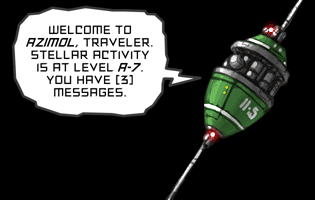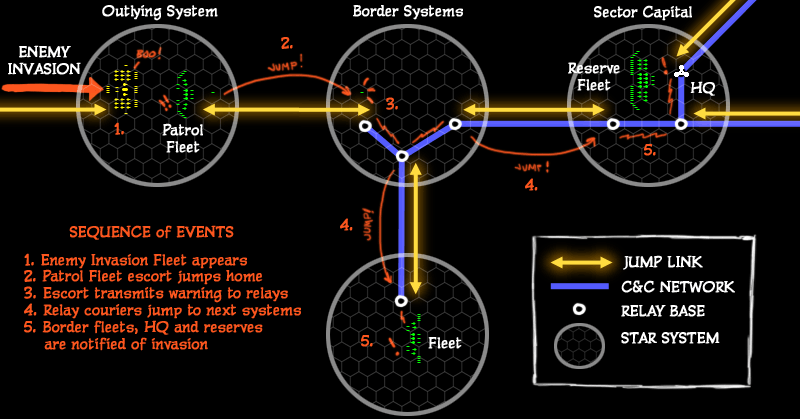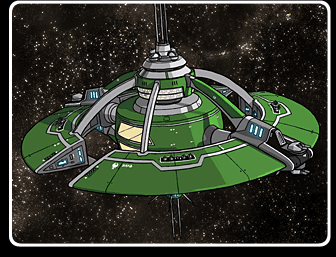|
Data
File Updated:
Wednesday, May 15, 2019
The only forces that can attack an enemy star system are
various kinds of starships. The most important defense element for any
star system is also a starship, because it is mobile and can be
where it needs to be at the appropriate time to face, follow,
pre-empt or avoid an enemy force. Purely defensive units and
installations have limitations, chiefly that they are usually
confined to a single system or location within a system, and
therefore can sometimes be avoided by a disobliging enemy.
However, there are often instances where a less-expensive
specialized system
defense unit makes more sense than a more-expensive multirole starship,
and there are some instances (such as the protection of a large
orbital spaceport) in which making such large craft jump-capable
is impractical.
The descriptions of system installations below are most
specific to Loroi examples, but apply in general to any
starfaring civilization at a similar level of technology.

System Infrastructure
The number, size and capabilities of system installations in
a particular star system will vary depending on the location of
the system (especially in relation to enemy borders), whether it
has inhabited worlds or outposts, and whether there is
significant transit traffic to and from nearby systems. A
remote, uninhabited system might only have a single system buoy,
whereas a homeworld may have dozens of stations with a wide
array of facilities.
With only a few exceptions such as ground bases, system
installations such as space stations
are NOT "fixed." Although they usually have no FTL drives, all of the
installations listed here are spacecraft, with at least some
limited ability to maneuver. Propulsion is necessary even for
the most basic satellites to maintain a stable orbit, and is
especially necessary for station-keeping in areas (such as near
a jump zone) which are not orbital. Maneuverability is also necessary to avoid kinetic
kill weapons which, while very primitive, are also
catastrophically damaging
if they can score a hit.
 System Buoys System Buoys
The most basic installation that will be in any controlled
system is at least one System Buoy, usually a small unmanned
satellite. The System Buoy transmits a constant stream of ID and
traffic control information, notifying passing vessels of system
conditions and hazards, and keeping a record of system transits.
The buoy is usually interactive and can be used by passing ships
as a signpost to leave messages and upload and download news and
network updates. Lone buoys are often placed in a long comet-like
orbit well out of the planetary plane of the system, to keep
interaction with system bodies to a minimum. Systems with a lot
of activity will have many such buoys at various
locations throughout the system, and a plethora of additional
special-purpose buoys for a variety of uses.
In the absence of faster-than-light communication
technologies, messages must be carried by starships. However, a
ship carrying conventional mail can require weeks or months to
travel from one location to another. The answer to improving the
speed of communication (vital to the operation of an
interstellar empire) is to use a kind of pony-express relay
system, that is an empire-wide network of courier vessels and
relay stations known as a Command and Control Network. The CCN works by using courier starships to make jumps between star
systems, but then using in-system communication infrastructure
to transmit messages across the system to another courier
starship waiting at the next jump point. This means that the
message can cross the system at the speed of light, instead of
being restricted to the realspace speed of a courier ship that
has to cross the system. A typical distance between jump points
at opposite ends of the same system is 80 Light Minutes, and a
courier vessel can get underway and up to jump speed in about an
hour, so it is possible for a message to cross ten systems in less than one day.
So, if a system is a part of the CCN, it will have at least
two Relay Bases situated near to the applicable jump zones that
lead to adjacent systems in the network. Each of these bases
will have at least basic communications infrastructure for
broadcasting clear messages across the system, but more
importantly will have fuel and operations facilities for a
stable of courier vessels. These couriers will operate between
the Relay Bases on each side of the jump link between the two
stars like net runners in a tennis match; a courier after
delivering a message will usually stay on the far side and
refuel, while another courier from the opposite base will make
the return jump.

(This diagram is based on one from
the game manual for Starfire: The Gorm-Khanate War.)
Observation Posts
For systems near a source of threat (such as an enemy
border), even if it isn't a normal part of the CCN, observation posts
to watch for incursions must also have similar bases that
support couriers so that any information gathered can be relayed
to headquarters.
Jump Link Traffic Control Issues
Because the only way to get information from the neighboring
system is via the arrival of a starship, there is a limited
amount that can be done to predict when and where an inbound
starship will appear. Normally, the chance of collision between
inbound and outbound starships is very unlikely, due to the
scales of the space involved. However, if there is enough
traffic through a particular jump link, the chances of collision
may rise to the point where it may be necessary (even if only
for reasons of psychological reassurance) to implement some kind
of jump traffic control scheme. Possible strategies include:
- One-way jump links. The most extreme but straightforward
safety measure, this specifies that a particular jump link
may only be used in one direction, and not in the other.
This is generally only practical if the system has multiple
usable jump links.
- Time-based restrictions on jump direction. The direction
in which a jump link may be used by traffic from a
particular side of the link is restricted to certain
designated hours of the day. This is probably the most
common traffic control scheme.
- Offset outbound jump lanes. In this scheme, outbound
traffic is required to jump from a lane that is offset by
several million kilometers from the optimal jump vector, so
that inbound traffic is less likely to appear near outbound
vessels. This adds a nominal element of risk to the outbound
jumps, but if that particular jump link has higher than
average safety factors (such as two relatively close, larger
stars), the added risk may be minimal.
- Required short- or deep-jump entry. Traffic in a given
direction is required to jump from shorter or longer than
the optimal jump point in order to shift the entry point in
the destination system. For example, if outbound traffic is
required to jump from closer to the departure star, it will
tend to appear farther from the destination star than
normal, lessening the likelihood of collision with outbound
traffic. As with offset outbound lanes, this strategy adds
risk to the successful jump.
Space Stations
Whether in various planetary, moon, or solar Lagrange orbits,
or keeping station near a jump point, space stations are
functional spacecraft with at least some ability to maneuver.
Battle Stations designed for combat may have thrust capability
as high as 5g and can change system locations on their
own; stations with less robust acceleration capability may rely
on tugs to move them in a more timely manner.
Various types of space stations can serve one or multiple
functions:
- Spaceport: a commercial port with docking facilities for
spacecraft and starships
- Shipyard: "dry dock" facilities for the service, repair
or construction of spacecraft
- Supply Depot: facilities for storage and dispensing of goods of various types, often
with an emphasis on fuel and munitions
- Space Habitat: living space for civilian populations;
usually must provide gravity through spin or artificial
means
- Planetary Access: provides surface-to-orbit access to a
planet via a shuttleport or orbital elevator
- Traffic Control: communications equipment and staff for
managing traffic (often on a relay station near a jump
point)
- Observation Post: active and passive sensor suites for
detection of hostile system incursions
- Communications Relay: powerful high-gain communications equipment
for cross-system broadcast
- Research Facilities: laboratories and data collection equipment
for studying nearby phenomena
- Power Plant: produces surplus power for external use,
such as via large solar arrays or reactors
- Training Facilities: most aerospace academies will have
at least some facilities on a local space station
- Operational Base: multiple facilities to support the
operations of a military starship fleet
- Fighter Base: provides hangar and service facilities for
military small craft
- Weapons Platform: mounts point defense and/or anti-ship
weaponry
- Space Fortress: the station is equipped with armor
and/or defensive screens to resist direct fire
Space Platforms vs. Battle Stations
Base Stations or "Battle Stations" are spacecraft with rigid hulls that are like starships
in most respects, but are optimized for system defense and have no
jump drive and much more limited propulsion. "Space Platforms" tend not to have
rigid hulls and are often modular, more fragile than bases, but
not as limited in size or growth potential. Platforms are
generally not designed for combat and therefore may suffer
catastrophic structural failures if they receive damage from weapons fire.
Our contemporary space stations such as the ISS or Mir would be
considered space platforms.
 Citadels Citadels
The Loroi term for a large, hardened, weaponized battle station is a
"Citadel." Loroi Citadels at frontline locations such as Seren or
Azimol have seen direct action and over the years have grown to
formidable sizes. Though Citadels are usually designed around
combat capability, they often provide a multitude of
station facilities: headquarters, logistics, support, habitat,
fighter hangars and extensive heavy weaponry and protection.
The largest battle station in Loroi space is Seren Citadel,
located in the sector capital near the Charred Steppes. The
first incarnation of the citadel saw heavy action during the
first Siege of Seren early in the war, and was destroyed when
Seren fell to the Umiak in 2139. It was rebuilt when the Loroi
recaptured Seren in 2145, bigger and better than before.
A battle station would be cheaper than a comparably-sized starship,
but not by orders of magnitude. A battle
station needs pretty much all the same systems that a starship
has, except for jump generators. A battle station still needs
engines, though it can spend less on the drive components, and
you'll still want artificial gravity and inertial dampers. It
can be larger and heavier than is practical to build most
starships, as it doesn't need to be as mobile and you don't have
to worry about jump field coverage, though if it's very large it
will probably have to be constructed in-system. It will also be
able to divert power that would have gone for high acceleration
into heavier weaponry.
I would guess that a battle station would cost perhaps 75% as
much as a starship of the same size, but is probably better
armed. If you have border systems like Seren or Azimol with
important bases that come under regular attack, then I think it
will make sense to build up a certain amount of local defenses.
There are very few border systems that still have large civilian
populations, so what needs to be protected is primarily your
military bases and their supporting infrastructure. If the
system needs orbital infrastructure such as spaceports and
depots and shipyards, then it makes some sense to build them as
hardened, armed stations that are more likely to survive an
attack (rather than constantly rebuilding cheaper civilian
platforms that are frequently damaged or destroyed). Second,
while it's true that battle stations can't leave the system to
aid in an attack on a different system, even the Loroi won't
want to move 100% of their forces to every hotspot; Farseers are
not 100% reliable, and important bases like Azimol and Seren
will need some kind of defense all the time, regardless of
whether there are attacks elsewhere. Battle stations can move
anywhere within a system, just not as quickly as more
conventional warships, and smaller battle stations can
potentially be relocated to other systems by jump-capable tugs.
Because the Umiak regularly and deliberately attack
high-value Loroi targets rather than trying to bypass them (in
order to force the Loroi to defend and thereby expose themselves
to casualties), I think it makes sense for the Loroi to build
fairly large and well-armed citadels in the major frontier
bases, supported by numerous smaller battle stations that can be
redeployed throughout the system as needed. If the planet has
airless moons, these will be good sites for ground bases. If the
planet is moonless, you might consider towing in an asteroid or
two, but I'm not sure that's really necessary.
The Umiak don't have Farseers and so must keep defensive
forces (or at least patrols) in every border system, so battle
stations might make sense, but they maintain very large
defensive reserve fleets that don't rush around to hotspots the
way the Loroi forces do, so battle stations are probably not as
necessary. It's also true that when the Loroi do go on the
offensive, they have a better record of breaking through than
the Umiak, so "fixed" Umiak defenses have a greater chance of
being bypassed than Loroi versions. I would expect the Umiak to
build mostly cheap orbital platforms for the infrastructure they
need, and rely primarily on their extensive fleets for defense.
Defensive Fleets
Starship fleets are usually a star system's best defense, and
key systems that are near enough to enemy threats will often
have starships based in the system or on regular patrol routes
through the system. Systems with a significant civilian
population will often have dedicated system security forces,
sometimes under the control of the interstellar government,
sometimes under the control of local governments or even private
firms. System security forces will often be primarily concerned
with local law enforcement.
If military fleets are not based directly in the system, it
may still be possible to call for aid using the CCN (or more
general courier vessels, if the system is not on the network).
Monitors
A "monitor" is a military spacecraft that is identical in all
ways to a starship with the exception that it does not have a
jump drive. These kinds of warships most often find use in very
heavily populated systems, where there will always be a need for
protection that does not need to leave the system. Monitors will
typically be used by local police forces or private security
firms, whose interstellar jurisdiction may be sharply limited
anyway.
DefSats
Defense Satellites are dedicated weapons platforms, usually deployed as
a last-ditch defenses around inhabited planets. DefSats are
usually unmanned and often armed with point-defense weaponry, to
protect a planet from missile barrages; however, some DefSats
are larger and armed with anti-ship weapons.
Fighters
Manned, maneuverable small craft are more expensive than
DefSats but
also more flexible. Fighters will usually be based on
carriers or stations in the system, though they may also
sometimes fly from ground bases on small, airless moons. Fighter
bases are possible on inhabited planets, but the atmosphere and
larger planetary mass will usually mean less than optimal
operation for a space fighter.
Mines
Mines are not well suited to space combat, because space is big and ships are small; collision with a mine
is astronomically unlikely. Even a remote-detonated mine with a
relatively huge blast radius is still very unlikely to provide
enough area coverage to be effective. Also,
there's no way to conceal a mine in open space, so they are
usually easy to spot and avoid (or destroy). Delayed-activation torpedoes can be
used in special circumstances as a sort of mine, but this is a low-efficiency use of a
fairly expensive resource.
 Planetary Installations Planetary Installations
Ground Bases are cheap and easy to maintain, but are often
less effective than space-based stations due to the effects of a
planet's gravity and atmosphere. Ground bases can be heavily
bunkered and protected, but are vulnerable in the sense that
they cannot dodge enemy fire, especially kinetic weaponry. Also,
defensive screens do not operate well in atmosphere.
Ground-based defensive installations can include: fighter or
missile bases, point-defense batteries, or anti-ship batteries.
Infantry barracks or other ground-combat-oriented facilities are
also common, but are outside the scope of this article.
Orbital Elevators
An orbital elevator (which is a cable leading from the ground
to geostationary orbit) is incredibly vulnerable and difficult
to protect, and any station connected to such an elevator also
becomes vulnerable because it loses most ability to maneuver. If
threatened, a station may be forced to detach from the elevator
cable so that it may maneuver freely, which may mean destruction
of the elevator.
Sentry Moons
Small airless moons are ideal sites for ground-based
defensive installations.
Defense Strategies and Defensive Tactics
Defensive installations alone can rarely repel a determined
fleet attack, therefore all viable defensive strategies are
centered around fleet battles, and the contribution of dedicated
system defense are usually secondary.
The question
then becomes: where does the defender choose to make his stand?
Defending Jump Zones
Any well-traveled system will usually want to have some kind of
station near the jump zone, to aid in traffic control, early
warning, and as a base for courier vessels if the system is on
the communications network. However, defensive installation will
often want to limit how close they are situated to the zone; in
addition to collision risks, they are likely to be quickly
destroyed if a major enemy force suddenly appears,
unless these defenses are very substantial.
Denial of a Jump Zone
An oft-mentioned idea is to attempt to make an inbound jump
zone unusable by flooding it with debris, in the hope that it
will cause collisions with inbound enemy vessels. The first
problem with this idea is that space is big and ships are small; it
would require an incredible amount of debris to fill the ~1 AU
wide volume that is a typical jump zone to any density that
would make the chance of collision significant. The second
problem is that this debris won't stay in the zone; because a
jump vector is fixed in relation to a nearby star, debris placed
in the zone will eventually fall in toward the sun or orbit out
of the zone. The third problem is that such debris
will pose a serious hazard to one's own side, both for friendly
vessels that want to use that jump link, and for system safety
in general as the debris diffuses out of the zone and clutters
up the system.
Defending Planets and Key Infrastructure
In some situations, such as combat out in the no-man's-land
of the Charred Steppes, there won't be any system installations
to defend at all, and the combatants may maneuver through the
system without restriction. In such a situation in which neither
side has any assets that must be protected (other than the
fleets themselves), one side may often be able to avoid combat
if it chooses. In a controlled system with assets that need to
be defended, the defender will be obliged to deploy his fleets
to protect them.
If the defender chooses to deploy near the asset, he will
have the advantage of whatever defensive infrastructure that has
been built around that asset. He will also have more time to
observe the enemy forces as they assemble at the jump point, and
assess the enemy's strength and disposition. This will give the
defender better options to retreat with his fleet intact if the
situation seems untenable. The disadvantage is that the enemy
will have time to marshal his forces in an orderly fashion. If
there are multiple such assets, this may require the defender to
split his forces.
If the defender chooses to deploy near to the jump zone, he
will have the advantage of being able to oppose the enemy fleet
entry into the system immediately, as the enemy vessels appear.
The advantage is that the enemy is likely to be disorganized as
they enter the system, and some species (notably the Umiak) will
be at reduced efficiency due to the effects of jump sickness.
The disadvantage is that the defender is committed to battle,
and may have limited time to prepare and limited option to
retreat if the enemy force is larger than expected. The defender
must also be certain which jump link the enemy is likely to use;
if the enemy enters the system from a different direction than
expected, it may not be possible for the defending forces to
redeploy in time to protect the key assets.
The defender can split his forces and guard multiple points,
but this will often mean that those forces guarding the jump
zone will be outnumbered and destroyed if the enemy comes
through in force. (You can probably guess which side favors this
tactic.)
In the state of the war at the time of the story, there are
not many planets with major population centers near the front
lines, as most of these have already been evacuated or
depopulated, so most assets that must be protected are military
and economic assets (bases, supply depots, resource gathering
operations).
Ground Combat
Ground combat is conducted with the same classes of weaponry we're
accustomed to (infantry, armor, artillery, air), and won't be
explored much in the story. Planetary invasions tend to be very
one-sided affairs: whichever side has space superiority
is going to have an enormous advantage in any ground combat,
being able to pound targets from orbit with relative impunity.
See also:
Weights and Measures: Scales.
Ground
Warfare
|
![]()
![]()
![]()
![]()


 System Buoys
System Buoys
 Citadels
Citadels Planetary Installations
Planetary Installations